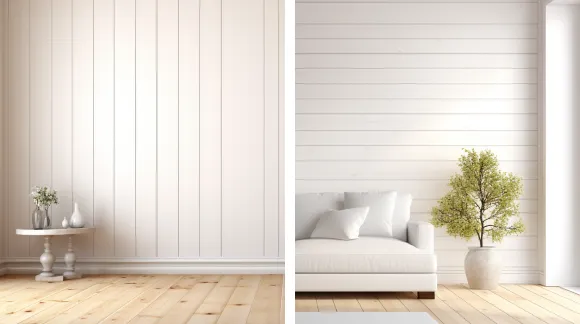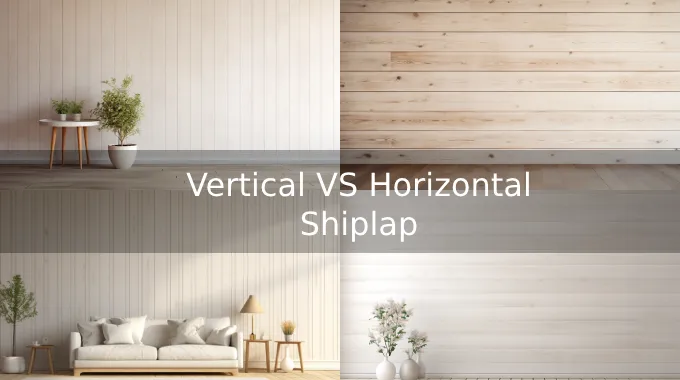Last Updated on September 16, 2023
Shiplap is one of the most popular materials used in interior design. In the realm of woodworking projects, vertical or horizontal shiplap has significant effects on both visual impact and practical considerations. So how can you decide what shiplap shape is best for your home decorating projects?
Vertical shiplap visually elongates rooms, making spaces feel taller. In contrast, horizontal shiplap accentuates width, creating a cozier atmosphere, often preferred in wider spaces.
Throughout this article, we will discuss the differences between vertical and horizontal shiplap, so that you can build a stunning DIY wall.
Differences Between Vertical and Horizontal Shiplap for Woodwork

Several key factors must be considered when choosing between vertical and horizontal shiplap for your woodwork.
- Orientation
- Visual perception
- Ceiling height
- Design style
- Light play
- Visual distractions
- Architectural features
- Exterior and interior application
For your carpentry project, let’s break down each of these factors better to understand the differences between vertical and horizontal wooden shiplap.
1. Orientation
Consider opting for a horizontal shiplap in your space to achieve a sleek and modern aesthetic.
In smaller rooms or spaces with low ceilings, horizontal shiplap gives the impression of width and spaciousness. The horizontal orientation draws the eye outward, creating the illusion of a larger area.
Meanwhile, vertical wooden shiplap refers to installing boards with their long edges aligned vertically. This creates a sense of height and depth in the space, making it ideal for rooms with high ceilings or narrow walls.
2. Visual Perception
If you want to create the illusion of a taller room, consider using a vertical shiplap. The direction in which the lines run can greatly influence the visual perception of a space.
Vertical shiplap tends to elongate the walls, making them appear taller than they actually are. This is because our eyes naturally follow vertical lines upwards, creating a sense of height.
On the other hand, horizontal shiplap can make a room feel wider but shorter. The horizontal lines draw our attention sideways, giving the impression of width rather than height.
3. Ceiling Height
Regarding vertical versus horizontal shiplap, the height of your ceiling is crucial in determining which direction will work best for your space.
Opting for vertical wood shiplap can be a game-changer if you have low ceilings. Drawing the eye upwards creates an illusion of height and adds a sense of spaciousness to the room.
Conversely, a horizontal shiplap might be more suitable if you have higher ceilings. It emphasizes the width of the space and can give a room with lofty ceilings a cozy and intimate feel.
4. Design Style
Consider your desired design style when choosing between the two options.
Vertical shiplap is a classic choice that brings a traditional and formal feel to any space. This style is often associated with more refined aesthetics like farmhouse or coastal designs.
Then again, horizontal shiplap offers a more modern and relaxed vibe. Horizontal shiplap is often used in contemporary or rustic designs, adding texture and warmth to the space.
5. Light Play
How light interacts with the shiplap can create interesting patterns that emphasize height or accentuate width.
Vertical shiplap can enhance the feeling of height in a room by letting light play along its lines. Whereas horizontal shiplap captures the light and bounces it around an entire space, creating a warm and cozy atmosphere.
6. Visual Distractions
Vertical shiplap draws the eye upwards, creating a visual distraction that diverts attention from any flaws or imperfections at eye level. By emphasizing vertical lines, the gaze is encouraged to explore the height of the space rather than focusing on any shortcomings.
Meanwhile, horizontal shiplap can shift attention sideways and highlight specific elements in the room, such as furniture or artwork. This orientation adds visual interest and creates a sense of balance and symmetry within the space.
7. Architectural Features
To enhance your space’s overall aesthetic, consider any existing architectural features. When deciding between vertical and horizontal shiplap, you should consider how they will complement or highlight certain elements in your space.
For example, if you have tall windows or doorways, a vertical shiplap can help draw the eye upwards and create a sense of height and grandeur. In contrast, horizontal shiplap can add visual interest and break up the monotony if you have long stretches of wall space without any significant architectural features.
8. Exterior and Interior Application
Both orientations can be used indoors and outdoors, with horizontal shiplap often chosen for exteriors due to its ability to shed water effectively.
A horizontal shiplap is installed with overlapping boards, creating a tight seal that helps prevent water from penetrating the surface. This makes it an excellent choice for protecting exterior walls against moisture damage.
On the other hand, vertical shiplap is commonly used for interior feature walls or accents. Its vertical lines add height and create a sense of visual interest in the space. Vertical shiplap can be painted or stained to match any interior design scheme, providing endless possibilities for customization.
Is vertical shiplap outdated?

Vertical shiplap is still a popular choice for creating a more modern and sleek look in home design when compared with horizontal shiplap. In fact, many designers are using vertical shiplap to create a sense of height and elegance in a space.
Color and texture changes can also update shiplap’s look, making it a versatile material that can be used in a variety of settings.
While horizontal shiplap may be appropriate in some design styles, vertical shiplap remains a relevant and popular choice for contemporary homes.
Is horizontal or vertical shiplap better for the kitchen island?
Try using a horizontal shiplap for your kitchen island to create a more modern and unified look with the rest of the space.
Horizontal wood shiplap is a popular choice for kitchen islands because it adds a touch of rustic charm while maintaining a clean and timeless aesthetic.
The horizontal lines create a sense of width and stability, making the island feel grounded in the overall design. It also allows for easier installation, as there are fewer cuts and angles to deal with compared to vertical wood shiplap.
Vertical shiplap also works well for kitchen islands but can create a more visually appealing statement. The vertical lines create a sense of upward depth, making the island appear taller and emphasizing its importance in the space.
Vertical or Horizontal Shiplap: What’s Best for You?
Whether to install shiplap vertically or horizontally is more than just a matter of preference when chisels meet wood and spaces transform. It combines spatial composition, visual storytelling, and architectural harmony.
By recognizing the nuances discussed herein, you can confidently shape your projects. Harness the power of vertical and horizontal shiplap to create living, breathing spaces that resonate with creativity and intention.



